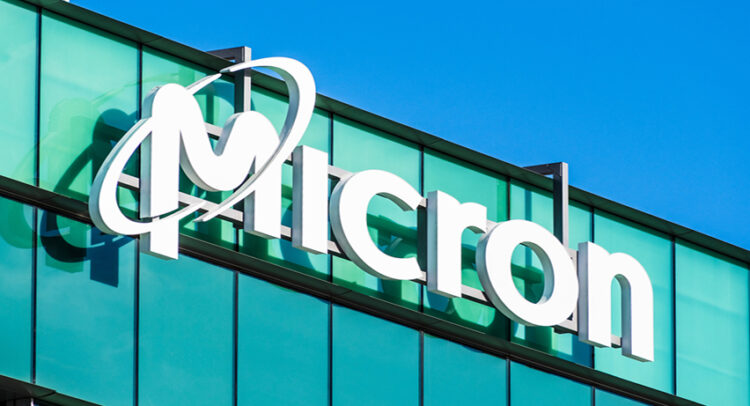
Micron Technology (NASDAQ:MU) Positioned for a Breakthrough Year
AI Revolution Powers Micron’s Future: Is MU Stock a Buy or Hold for 2025? | That's TradingNEWS
Micron Technology (NASDAQ: MU): Is It Time to Buy or Hold? A Deep Dive Into the Stock’s Future Potential
Memory Market Dynamics Impacting NASDAQ:MU
As the global economy adjusts to the post-pandemic reality and industries like AI, autonomous driving, and data centers gain traction, the demand for memory chips is expected to grow. Micron, alongside its two major competitors—Samsung and SK hynix—dominates the high-bandwidth memory (HBM) chip market, essential for high-performance computing applications.
Recovery from the 2023 Downturn and FY 2024 Momentum
After a difficult fiscal year in 2023, where NASDAQ:MU saw a 50% YoY revenue decline, the company is now on a path to recovery. In FY 2024, Micron’s traditional PC, mobile, and enterprise customers returned, replenishing inventory levels that were depleted during the pandemic. This inventory normalization is combined with the growing demand for memory chips in AI applications, creating momentum for a substantial rebound.
Micron's fiscal year 2024 performance has shown encouraging signs. The company's revenue, although down in 2023, started to recover toward the end of FY 2024, as reflected in its Q4 results. Micron reported revenue of $7.8 billion in the fourth quarter, marking a 93% year-over-year increase, driven by increased bit shipments and higher average selling prices (ASP) in both DRAM and NAND segments.
DRAM Market Leadership Micron’s DRAM products, which account for 70% of its revenue, have been a focal point of its growth strategy. In FY 2024, DRAM ASPs increased in the mid-teens sequentially, a stark improvement from FY 2023, where ASPs declined. This uptick signals strong demand in markets like cloud computing, AI-driven applications, and 5G infrastructure.
Micron’s 1β node technology for DRAM production has given it a competitive edge, enabling the production of more advanced chips at lower costs. However, it’s important to note that Samsung and SK hynix are not far behind, with both companies ramping up their own production capabilities. This tight race underscores the competitive nature of the memory market, but Micron’s leadership in HBM3E chips, crucial for generative AI applications, positions it well for continued dominance.
Micron's Partnerships and Technological Advancements in HBM
Micron’s advancements in High Bandwidth Memory (HBM) and its partnerships with industry giants such as NVIDIA provide a significant tailwind for the company. Micron's 12-Hi HBM3E memory stacks, with a capacity of 36GB and over 1.2TB/s of memory bandwidth, are designed for cutting-edge AI workloads. These chips, which are 50% more power-efficient than previous models, are expected to drive significant revenue growth as data centers and AI applications continue to expand.
The AI revolution is not just a passing trend; it’s driving demand for high-performance memory solutions that Micron specializes in. NVIDIA’s GPUs, which rely on Micron’s memory products, are critical in training large AI models. As AI adoption continues to rise across industries—from autonomous driving to cloud computing—Micron is positioned to capture substantial market share.
Micron's Financial Performance and Valuation
Micron’s financial recovery is evident in its improving margins. In Q4 FY 2024, the company reported a GAAP gross margin of 35.32%, compared to negative margins during the previous downturn. Micron’s operating margins also improved, reaching 19.65%. These metrics highlight the company’s ability to manage costs effectively while navigating the cyclical nature of the memory chip market.
Micron’s forward EV/EBITDA multiple currently stands at approximately 6x, which, given its strong positioning in the AI-driven hardware space, suggests significant upside potential. In comparison, its competitors, such as SK hynix and Samsung, trade at lower multiples, indicating that Micron’s valuation may reflect its leadership in high-performance memory technologies.
CapEx Investment and Strategic Outlook for 2025
Micron is also making significant investments in its future growth. The company plans to increase capital expenditures (CapEx) in FY 2025, focusing on expanding its production capacity for DRAM and NAND chips. This investment includes the construction of new fabs and the development of next-generation memory technologies like GDDR7, which will further enhance its competitive position.
Micron’s CapEx for FY 2025 is expected to be around $9 billion, with a focus on advancing its node technology and increasing its supply of HBM chips to meet rising demand from AI applications. These investments are expected to drive revenue growth in 2025 and beyond, as Micron capitalizes on the growing demand for memory in data centers, autonomous vehicles, and other high-performance computing environments.
Challenges Ahead: Competition and Market Risks
Despite the positive outlook, Micron faces several challenges. The commoditized nature of the memory chip market means that prices are heavily influenced by supply and demand dynamics. While the current demand for AI and data center applications is strong, any oversupply in the market could lead to price declines, negatively impacting NASDAQ:MU.
Additionally, Micron’s competitors, Samsung and SK hynix, are not standing still. Both companies are investing heavily in their own memory technologies and expanding production capacity. Any missteps by Micron in executing its strategy could result in lost market share to these rivals.
Another risk factor is the broader economic environment. Interest rate changes, geopolitical tensions, and supply chain disruptions could all impact Micron’s ability to maintain its current growth trajectory.
Buy, Sell, or Hold? Micron’s Investment Outlook
Given Micron’s strong recovery in FY 2024 and its strategic investments in next-generation memory technologies, NASDAQ:MU appears well-positioned to benefit from the ongoing AI revolution. The company’s partnerships with NVIDIA and other key players in the AI space provide additional tailwinds for future growth. With memory chip demand expected to remain robust, particularly in high-performance computing and data centers, Micron is set to capture a significant portion of this market.
However, investors should remain mindful of the cyclical nature of the memory market and the potential for price volatility. Micron’s stock price has historically been subject to sharp fluctuations, and while the current outlook is positive, any changes in supply-demand dynamics could impact its valuation.
Final Thoughts: A Strong Buy with Upside Potential
Micron’s recovery from the 2023 downturn, combined with its leadership in high-performance memory chips, makes NASDAQ:MU a compelling investment opportunity. With a forward EV/EBITDA of 6x and significant growth potential in AI-driven markets, Micron offers attractive upside for investors willing to navigate the cyclical nature of the memory industry.
If Micron can continue to execute its strategy and capitalize on the growing demand for AI and data center applications, the stock could see substantial gains in the coming years. For investors with a long-term horizon and the ability to weather short-term volatility, NASDAQ:MU remains a strong buy.
















